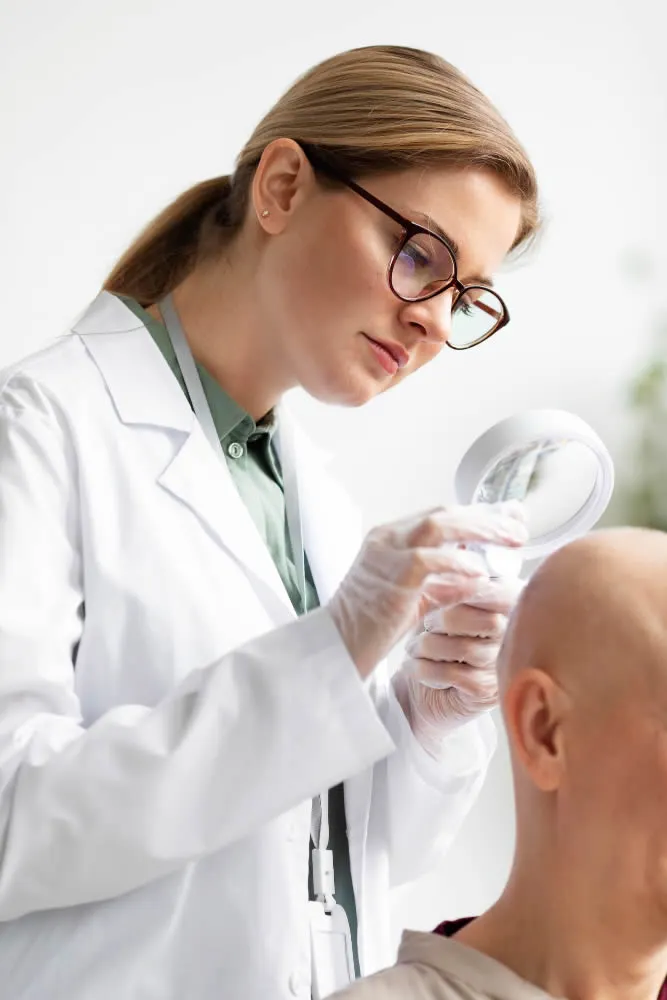What is Sebaceous Carcinoma?
Sebaceous carcinoma, pronounced “suh-BAY-shus,” emerges as a rare skin cancer originating from oil-producing glands within the skin. These sebaceous glands, responsible for producing protective sebum, can be found extensively beneath the skin’s surface, especially in areas with hair.
While it predominantly targets the eyelids, sebaceous carcinoma can develop anywhere on the body. Its aggressive nature is evident through rapid spread, classifying it as metastatic cancer when it extends beyond the initial site.
Under various aliases like sebaceous gland carcinoma or meibomian gland carcinoma, it’s a formidable adversary seldom seen, affecting a mere 1% of eyelid tumors and presenting unique challenges in diagnosis and treatment.

What are the causes and risk factors of Sebaceous Carcinoma?
What are the symptoms of Sebaceous Carcinoma?
Advanced sebaceous carcinoma reveals a range of symptoms that warrant attention. Left untreated, this aggressive skin cancer can trigger various manifestations, including:
- Loss of eyelashes, a concerning sign of its impact on the delicate eye area.
- Oozing growths on both upper and lower eyelids, a distressing consequence of the disease’s progression.
- Reddish eyes that resemble conjunctivitis, a symptom that can raise alarm.
- Vision problems, a grave concern due to the potential impairment it poses.
How is Sebaceous Carcinoma treated?
The arsenal of treatments for sebaceous carcinoma encompasses diverse strategies tailored to the individual’s condition.
Surgical avenues take the forefront:
-
Wide Local Excision: A meticulous procedure that removes the tumor and a normal tissue margin. This helps ensure the cancer’s thorough elimination.
-
Mohs Surgery: Employing a staged approach, Mohs surgery incrementally removes the cancerous tumor and surrounding healthy tissue. During the procedure, thin slices of tissue are examined to gauge the need for further excision, guaranteeing complete eradication of cancer cells.
-
Radiation Therapy: Reserved for cases where surgery isn’t feasible, radiation therapy targets the cancer cells with high-energy rays, inhibiting their growth and division.

FAQ about Sebaceous Carcinoma
What distinguishes Sebaceous Carcinoma from Sebaceous Hyperplasia and Sebaceous Cysts
Sebaceous hyperplasia is a benign growth within hair follicles, while sebaceous cysts are noncancerous growths forming beneath the skin due to clogged sebaceous glands.
When should I seek medical attention for skin growths or changes?
It’s advisable to consult a healthcare provider if you notice any unusual growths on your skin, especially around the eyes, or experience changes in moles or birthmarks.
What questions should I ask my dermatologist about Sebaceous Carcinoma?
Some relevant questions include understanding the causes, potential risks, suitable treatment options, and the need for cancer screenings based on your individual circumstances.
Is there a connection between hormonal changes and the development of Sebaceous Carcinoma?
While no direct link has been established, hormonal changes might influence the risk, but more research is needed for a conclusive answer.
Is there a dermatologist near me in Salt Lake City that offers treatment for Sebaceous Carcinoma?
Yes. At our Salt Lake City dermatology office we offer treatment for Sebaceous Carcinoma to patients from Salt Lake City and the surrounding area. Contact our office today to schedule an appointment.

